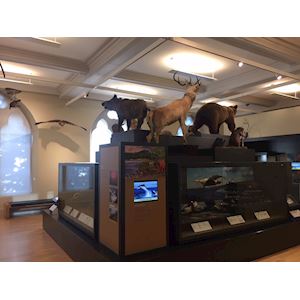
07. MAMMALS IN LANDSCAPE AND LIVES
This gallery displays many different kinds of mammals. Here you can see animals currently found in Scotland, along with some that were formerly found here, but are now extinct. Taxidermy allows you to see what these mammals look like up close, something that’s difficult to do in the wild. Look for the Red Deer stag. This is the largest surviving native land mammal in Scotland. It can weigh close to 150 kilos. During the rutting season in autumn, the deer uses its antlers to intimidate other stags, when males compete for female red deer for breeding. Large predators, such as the Brown Bear, Wolf and Lynx, were hunted to extinction in Scotland, because they were thought to be dangerous to livestock, and potentially a risk to humans as well. These mammals were in competition with man, for the same prey. In contrast, deer and hares have survived. As game animals, they’re hunted for sport and food. As you move around the display, you can also see a European beaver. By the 16th century, humans had hunted beavers in Scotland to extinction. They used the animals for food and fur. They also used an oily excretion from beavers, called castoreum, for medicine. As a result of official reintroduction trials, and escaped captive animals, beavers can now be seen in the Scottish landscape once again. After you’re finished exploring this Landscape and Lives gallery, please continue through to the next gallery, called Landscapes and Lives 2.


The McManus: Dundee's Art Gallery and Museum
The McManus: Dundee’s Art Gallery and Museum is situated in the centre of Dundee. The Museum and Art Gallery originally known as the Albert Institute was opened in 1867 as a memorial to Prince Albert. In 2005 The McManus closed for a major refurbishment, reopening again on the 28th February 2010. We celebrated our 150th Anniversay in 2017 with a year of celebration. In 2020 we were awarded Visitor Attraction of the Year by Visit Scotland. The McManus has 8 galleries, which are laid out on 2 floors. Visitors can embark on a journey through 400 million years, and witness how a small settlement developed into the City of Dundee as it is today. From exhibits relating to the life of early man in the area, stunning paintings and decorative art through to artefacts from industries past and present, the City's collections, many of which are recognised as being of national significance, give an insight into Dundee and its people.
- The McManus: Dundee's Art Gallery and Museum
- Dundee United Kingdom
- www.mcmanus.co.uk
